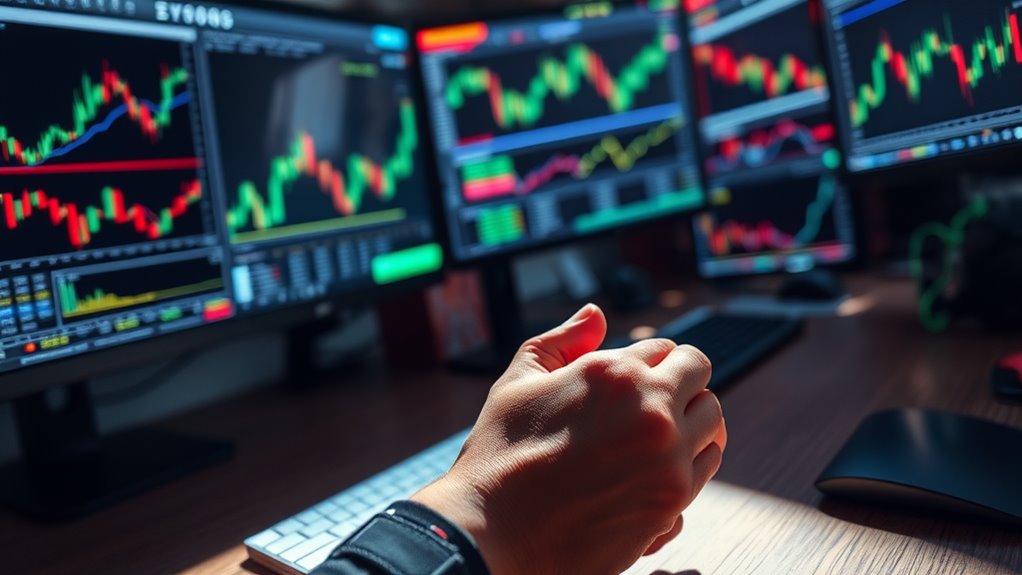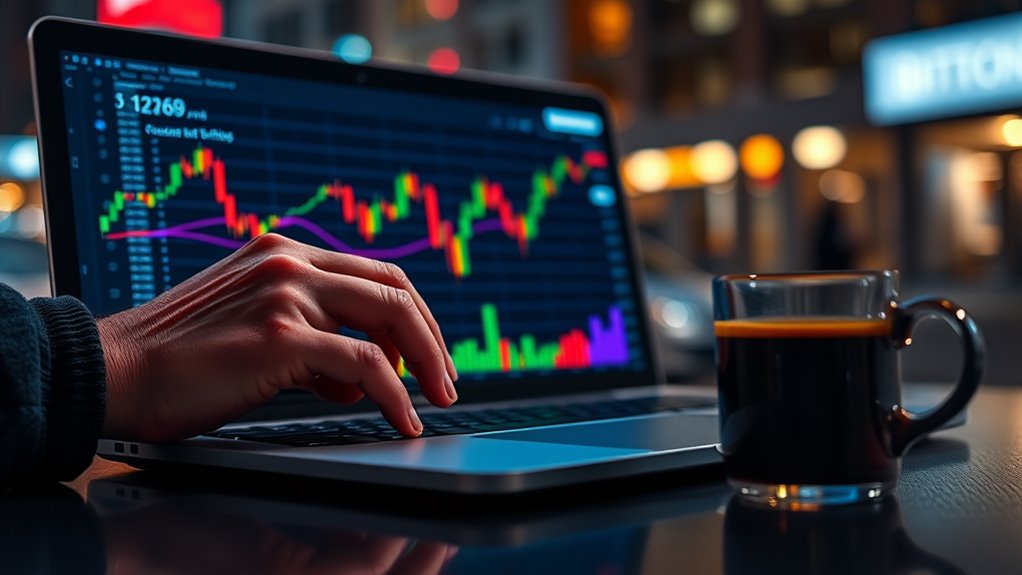
Crypto Market Psychology: How Traders Think
Crypto market psychology refers to the emotional and cognitive influences on traders in a volatile environment. Key emotions, such as fear and greed, drive impulsive decisions, often fueled by FOMO and FUD. Traders also face cognitive biases like overconfidence and loss aversion, affecting their judgment. Social media amplifies these emotions, leading to herd behavior. Understanding these factors is essential for effective trading. By exploring these dynamics, traders can develop strategies for more informed and resilient decision-making.
Table of Contents
Key Takeaways
- Traders are influenced by dominant emotions like fear and greed, leading to impulsive decisions during market volatility.
- FOMO drives many trades, causing impulsive buying when prices surge, while FUD leads to panic selling during downturns.
- Cognitive biases, such as overconfidence and confirmation bias, cloud traders’ judgment and exacerbate emotional reactions to market changes.
- Social media amplifies market sentiment, fostering herd behavior and creating rapid shifts in trading strategies based on influencer opinions.
- Structured trading plans and mindfulness practices help traders manage emotions and make informed decisions, enhancing resilience against market fluctuations.
The Emotional Landscape of Bitcoin Trading

The emotional landscape of Bitcoin trading is shaped by a variety of psychological factors that influence traders’ decisions and behaviors. Fear and greed are two dominant emotions, often leading to impulsive actions such as panic selling or reckless buying.
Market volatility exacerbates these feelings, creating stress that affects rational decision-making. Additionally, social media plays a significant role, amplifying emotions and fostering herd behavior among traders.
Cognitive biases, like overconfidence and confirmation bias, can cloud judgment, resulting in risky investments. To navigate this emotional terrain, effective risk management strategies are essential. Understanding market volatility can help traders mitigate emotional trading traps and make more informed decisions.
Understanding FOMO in Cryptocurrency Markets

FOMO, or “Fear of Missing Out,” greatly impacts investment behavior in cryptocurrency markets. This psychological phenomenon drives many investors to make impulsive decisions, often due to extreme price volatility and social media hype.
Influencers and significant announcements can trigger mass FOMO, leading to rapid price surges. Many investors, motivated by the fear of missing out on potential gains, tend to buy at market highs rather than waiting for dips.
Research indicates that 84% of crypto holders make choices influenced by FOMO, frequently resulting in emotional trading without thorough analysis. Consequently, this behavior can lead to substantial portfolio losses and a focus on short-term gains, overshadowing the benefits of long-term investment strategies and careful planning. To mitigate FOMO, savvy traders often employ strategies for taking advantage of BTC’s volatility, allowing them to make more informed decisions amidst market fluctuations.
The Role of FUD in Influencing Trader Behavior

Influencing trader behavior, FUD, or “Fear, Uncertainty, and Doubt,” plays a significant role in the cryptocurrency markets. This phenomenon often arises from negative or misleading information spread through news reports, social media, or regulatory announcements.
FUD can lead to increased market volatility, triggering panic selling and significant price drops. The unique nature of cryptocurrencies, characterized by speculation and a lack of regulation, makes them particularly susceptible to FUD.
As rumors and misinformation circulate, they amplify uncertainty, leading traders to make impulsive decisions driven by fear. Additionally, influential figures can exacerbate these sentiments, deepening market turbulence.
Consequently, understanding FUD’s impact is essential for traders aiming to navigate the emotional landscape of cryptocurrency investments effectively.
Behavioral Biases Impacting Bitcoin Investors

Behavioral biases greatly influence Bitcoin investors, particularly overconfidence in trading decisions and loss aversion.
Overconfidence can lead investors to make risky trades, believing they can predict market movements more accurately than they can.
Meanwhile, loss aversion often causes investors to hold onto losing positions longer than advisable, fearing the realization of losses rather than focusing on potential gains.
Overconfidence in Trading Decisions
Overconfidence can greatly shape trading decisions in the cryptocurrency market, particularly among Bitcoin investors. This cognitive bias leads traders to overestimate their knowledge and abilities, resulting in high-risk trades and prolonged holding of losing positions.
Beginners may initially experience success, fostering an inflated sense of market understanding. Consequently, they might underestimate risks, leading to concentrated, high-risk portfolios.
Additionally, confirmation bias causes traders to seek information that supports their beliefs while neglecting contrary evidence, further entrenching their overconfidence. Emotional involvement in trading can lead to impulsive decisions influenced by fear and greed.
Ultimately, this overconfidence can result in significant financial losses and increased market volatility, highlighting the importance of self-awareness and risk management strategies in trading practices. As Bitcoin’s role in future global finance evolves, the impact of investor psychology will continue to play a critical role in market dynamics.
Loss Aversion and Holding
Loss aversion profoundly affects how Bitcoin investors make decisions, often leading to a reluctance to sell assets during price declines. This behavioral bias causes investors to prioritize avoiding losses over pursuing gains, resulting in emotional decision-making.
Factors contributing to this phenomenon include:
- FOMO and FUD: Fear of Missing Out and Fear, Uncertainty, and Doubt can intensify loss aversion.
- Social Influence: Community opinions and social media trends can heighten emotional responses.
- Confirmation Bias: Investors may only acknowledge information that supports their existing beliefs, reinforcing loss aversion.
- Market Volatility: Bitcoin’s price fluctuations can trigger impulsive selling or holding decisions.
Understanding these factors can help investors develop strategies to manage their emotions and improve decision-making during challenging market conditions. Additionally, social media trends play a crucial role in shaping market narratives, which can further amplify loss aversion among traders.
The Psychology of Market Sentiment

Market sentiment plays an essential role in shaping the dynamics of the cryptocurrency landscape. Emotional drivers such as fear, greed, and euphoria heavily influence traders’ decisions, often leading to dramatic market movements.
Cognitive biases like confirmation bias and loss aversion further complicate the decision-making process, resulting in behaviors that can amplify market trends. External factors, such as regulatory news and social media influences, also greatly sway sentiment, guiding traders toward bullish or bearish attitudes.
Tools like the Crypto Fear & Greed Index offer insights into prevailing market emotions, allowing investors to gauge sentiment more effectively. Understanding these psychological elements is vital for maneuvering the complex environments of cryptocurrency trading and making informed decisions.
Navigating Volatility in Bitcoin Trading

Maneuvering the landscape of Bitcoin trading requires an understanding of its inherent volatility, which can greatly impact investor behavior and decision-making. Traders often face challenges due to fluctuating prices, leading to emotional responses that can affect their strategies.
Navigating Bitcoin trading demands a grasp of its volatility, as price fluctuations can significantly influence trader psychology and strategy.
Key aspects to take into account include:
- Volatility Levels: Bitcoin’s recent historical low in weekly volatility indicates a shift in market dynamics.
- Realized vs. Implied Volatility: Many traders overestimate volatility, creating a mismatch between perceived and actual risks.
- Market Capitalization Impact: Despite low volatility, Bitcoin’s market cap growth suggests increasing investor confidence.
- Emotional Trading Behavior: Fear of loss can lead to impulsive decisions, highlighting the psychological complexities of trading.
Moreover, many investors view Bitcoin as an inflation hedge, which can influence their trading strategies and decisions. Understanding these factors is essential for making informed trading decisions.
Social Media’s Influence on Trader Psychology

The influence of social media on trader psychology has become a significant factor in the cryptocurrency market. Social media fosters phenomena like FOMO (fear of missing out) and herd mentality, pushing traders to make impulsive decisions. The rapid dissemination of information can overwhelm traders, while influencers shape market perceptions. Behavioral biases, such as confirmation bias and overconfidence bias, are amplified by social media narratives. Additionally, the psychological stress associated with constant updates can lead to anxiety and sleep disturbances.
| Social Media Influence | Psychological Impact |
|---|---|
| FOMO and Emotional Contagion | Anxiety and Depression |
| Herd Mentality | Overconfidence Bias |
| Information Overload | Disposition Effect |
| Influencer Impact | Loss Aversion |
Strategies to Combat Emotional Trading Decisions

When traders become aware of their emotions and how these feelings can impact decision-making, they are better equipped to make rational choices in the volatile world of cryptocurrency.
Implementing effective strategies can help mitigate emotional trading decisions:
- Emotional Awareness: Recognizing how emotions like fear and greed influence decisions allows traders to avoid biases.
- Structured Trading Plan: Establishing clear entry and exit points supports disciplined trading, reducing impulsive actions.
- Risk Management Techniques: Utilizing tools like stop-loss orders helps limit losses, enhancing overall risk management.
- Mindfulness Practices: Engaging in meditation or similar activities can reduce emotional reactivity, fostering calmness in trading situations. Additionally, traders can benefit from employing technical indicators to make more informed decisions amidst emotional turmoil.
The Stages of Market Cycles in Bitcoin

Understanding the stages of market cycles in Bitcoin is essential for traders looking to navigate its volatile landscape effectively. The cycle consists of four main phases: Accumulation, Growth, Bubble, and Crash.
During the Accumulation phase, bearish sentiment prevails, leading to price stability and low trading volumes, creating buying opportunities for experienced investors. As demand increases, the market enters the Growth phase, characterized by rising prices and improved sentiment.
This can escalate into a Bubble phase, marked by exponential price surges and high volatility. Finally, the Crash phase follows, where panic selling occurs, and prices can drop considerably. Historically, Bitcoin’s price movements have demonstrated significant volatility that often aligns with these market cycle stages.
Each stage reflects shifts in market psychology and influences future cycles, reinforcing the importance of understanding these patterns for successful trading.
Building Resilience as a Bitcoin Trader

Building resilience as a Bitcoin trader involves understanding emotional triggers that can affect decision-making, particularly during market fluctuations. Developing effective risk management strategies is essential to safeguard investments, while learning from market setbacks can provide valuable lessons for future trades. Additionally, implementing short-term trading strategies can help traders navigate the volatile crypto market more effectively.
Understanding Emotional Triggers
Emotional triggers play a significant role in the decision-making process of Bitcoin traders, as their reactions often stem from underlying feelings like fear and greed.
Understanding these triggers is essential for developing resilience in trading.
- Fear and Greed: These emotions can lead to impulsive decisions, resulting in significant losses or missed opportunities.
- FOMO: Traders often buy during peaks, driven by the fear of missing out on potential profits.
- FUD: Panic selling during downturns occurs due to fear, uncertainty, and doubt.
- Overconfidence: Traders may overestimate their skills, which can lead to higher risk-taking.
Developing Risk Management Strategies
Effective risk management strategies are essential for Bitcoin traders aiming to navigate the unpredictable nature of cryptocurrency markets. Traders can employ several key techniques to protect their investments. Diversification, for instance, spreads risk across various assets, reducing potential losses from any single asset’s decline. Additionally, setting a risk budget limits losses to a manageable percentage of total capital, typically 1-2%. Implementing stop loss orders automates selling at predetermined prices, further minimizing losses. Consistency in following these strategies is vital, as it helps curb emotional decision-making. Furthermore, traders should be aware of how energy costs can influence hardware performance and ultimately impact their trading strategies.
| Strategy | Description |
|---|---|
| Diversification | Spreading investments across multiple assets |
| Risk Budgets | Limiting maximum loss per trade |
| Stop Loss Orders | Automatic sell orders at specific price points |
Learning From Market Setbacks
Market setbacks are an inevitable part of trading in the cryptocurrency landscape, and understanding how to learn from these experiences can greatly contribute to a trader’s resilience.
Embracing setbacks allows traders to develop strategies that enhance their emotional strength and decision-making abilities. Key strategies include:
- Understanding Behavioral Biases: Recognizing emotions such as fear and greed helps traders make informed decisions.
- Emotional Control: Maintaining composure during market fluctuations prevents impulsive actions.
- Long-Term Focus: A long-term perspective minimizes the impact of temporary downturns.
- Learning from Mistakes: Viewing losses as educational opportunities fosters growth and resilience.
Additionally, traders can benefit from recognizing Bitcoin’s role as a long-term store of value, which can provide a solid foundation for their investment strategies.
Frequently Asked Questions
How Can I Develop Emotional Awareness While Trading Cryptocurrencies?
To develop emotional awareness while trading cryptocurrencies, individuals should implement clear trading plans, practice mindfulness, utilize automated systems, take regular breaks, and engage with demo accounts to enhance resilience and reduce impulsive decision-making.
What Role Does Discipline Play in Successful Crypto Trading?
Discipline and impulsiveness stand in stark contrast in crypto trading. Successful traders prioritize adherence to plans and risk management, ensuring emotional control. This dedication fosters consistent performance, allowing them to thrive amidst market volatility and uncertainty.
How Can I Identify Market Sentiment Shifts Effectively?
To identify market sentiment shifts effectively, one should analyze the Fear and Greed Index, monitor trading volume changes, assess options data, and evaluate social media trends, as these indicators provide valuable insights into prevailing market emotions.
What Tools Can Help Automate My Trading Strategy?
Over 70% of traders utilize automation tools to enhance efficiency. Platforms like 3Commas and Cryptohopper offer customizable bots, while Bitsgap provides advanced strategies, making automation an essential component for optimizing trading performance and managing risk effectively.
How Can I Counteract Herd Behavior in My Trading Decisions?
To counteract herd behavior in trading decisions, individuals should conduct independent research, establish a clear trading plan, utilize risk management tools, and maintain a diversified portfolio, thereby reducing emotional influences and enhancing decision-making efficacy.
Conclusion
In summary, understanding the psychological factors that influence cryptocurrency trading is essential for success. As the saying goes, “Keep your friends close and your emotions closer.” By recognizing emotions like fear and greed, traders can make more informed decisions. Awareness of market cycles and social media’s impact also plays a significant role in shaping behavior. By developing resilience and employing strategic approaches, traders can navigate the volatile landscape of Bitcoin with greater confidence and clarity.




